I Remember Joan
by Adele
Whitely Fletcher
Originally appeared
in Modern Screen, August 1977
At ten o'clock on the morning of May 10th, Joan Crawford died of cardiac arrest at her New York apartment. Her maid found her on the floor of the livingroom.
Joan died, two months after her 69th birthday, as she never had lived -- easily. Had there been someone with her who knew the proper procedure for stimulating a heart to beat again, her life might have been saved. But there was no one.
Cardiac arrest occurs, usually, when a heart is in poor condition. Joan, however, had complained only of recent back pains becoming more severe. But, seemingly aware she was in trouble, she had -- three days before she died -- made arrangements for her little champagne-colored dog, "Princess", to have a good home with a friend.
She would have taken the greatest satisfaction from the importance of her death received on radio, television, and in the world press; proof-positive she had remained a great star.
She would have smiled her quick, pleased smile at the Memoriums: U.S.O. officers, directors and staff expressing sorrow at the loss of "an outstanding American" and their distinguished director and vice-president...the Muscular Dystrophy Association's profound sorrow at their loss of "a corporate member and staunch friend who, for ten years, had made generous contributions of her enormous talents"...the officers of Brandeis University mourning the death of a dedicated Fellow.
Even Joan's closest friends were surprised at the extent of her philanthropies. She'd never talked about them, except to say, "I've been on the receiving end of so many good things I have to give something in return."
Also, had it been possible, I think she would have stolen a triumphant glance at those of us who had sometimes criticized her for being overly-strict with her four adopted children: Christina Koontz, Christopher Crawford, and her twins, Cynthia Jordan and Cathy LaLonda, the last three parents of her eight grandchildren. For they all behaved impeccably.
In accordance with her wishes, Joan was cremated and, following a private service, her ashes were interred beside the ashes of her last husband, Alfred Steele.
Let anyone who wants to read a sweetness and light story about Joan turn the page. She wasn't like that. She was a strong dame, always willing to work for what she wanted -- and usually got -- and quick to say what she thought.
For the celebrities who slump around with unkempt hair and sloppy jeans she had scorn, saying vehemently: "They're not stars! They're personalities. Personalities come and go. Stars last!"
I knew Joan for 50 years, from the time M.G.M. signed a chorus girl from New York's Winter Garden to a contract and, deciding her name of Lucille LeSueur was impossible, initiated a magazine contest with a $500 prize for a winning name. There were, of course, eminent judges. When they did not appear for the judging I, as editor, chose Joan Crawford as the winning name. Lucille Le Sueur hated that name, until it turned into pay-dirt with the relentless effort and incredible self-discipline she put behind it.
Joan worked as hard at being a star, in the studios and in her private life, as she'd worked from the time she was 9 years old -- helping her mother in a laundry, as a waitress, as a salesgirl and as a drudge in the private school where, for her tuition and a pittance, she did all the housework for 30 boarders.
She never let down her star image, even after she left Hollywood for New York. On a busy day she might change costume, hairdo and make-up four times. She went about in a limousine, with a telephone, a crystal vase of fresh flowers and a courteous, liveried chauffeur. At the famous # 21 Club, on her favorite table at the head of the stairway, a bottle of Pepsi Cola always stood prominently beside the flowers. And when word got around she was there, as it always did, she would leave a little early, so she would have time to shake hands, sign autographs and talk with those who waited to see her.
Not that there ever was anthing "la-de-da" about her. I've seen her scrub floors. And one early morning I found her, hair pinned back, wearing a yellow house-coat, sitting on the floor filling cartons with books from her shelves.
"For the library at Brandeis," she explained.
She was not, as might have been expected, dust-smudged. Her shelves and books were clean even when she had to clean them herself.
From the day Joan arrived in Hollywood, where she first earned $75 a week, she worked ceaselessly towards becoming a star. Aware that her youthful plumpness, attractive in a chorus line, would be exaggerated by the cameras, she jogged every morning before going to the studio, even when she had a 6:00 AM call; this in a day when no one but athletes had ever heard of jogging.
She changed constantly during her early Hollywood years. When, after we hadn't seen each other for months, she demanded to know why, I said "I don't know what to expect from you any more, Joan! Every time I see you you're different!"
"What's wrong with that?" she wanted to know. "It means, I hope, that I'm growing!"
I was properly silenced.
The most talked about phase of her growing was called "Crawford's White Phase". She wore white only. Every time she took off a dress or a suit it went to the cleaners. The furniture in her Brentwood house, the first evidence of her appreciation for the strikingly pure line of eighteenth-century English, was upholstered in white. Previously her house had been in Spanish inside as outside -- and although a little imposing, far preferable to her earlier decor of beaded lamp-shades and fringed furniture over which she came to laugh and shudder.
To what, a psychiatrist would ask, was all this a reaction?
One evening during her white phase her maid, about to leave for a ball, stopped in the hallway for Joan to check her appearance. She, very black, was all in white, exactly like Joan -- even to the gardenia clasped in her little white bag.
When she'd gone and we all gave way to laughter, Joan glared, very angrily.
"What's so funny?" she asked. "Give her credit! She's learning!"
She would be very kind, very loyal. When I was sufficiently admiring of the novels of her good friend, Jacqueline Susann, she asked if I'd read Geraldine. I hadn't. So the next day it was in the mail; a tale of a suburban pigeon that flies to the lights of Broadway. It was lovely!
On Joan's desk was a brass turtle, one of Jacqueline's last gifts. Twist its tail and a bell that sounded like a telephone bell went off. She said:
"When I'm trapped on the telephone by someone who has nothing else to do but talk endlessly, I twist that tail and tell them, 'Sorry! That's my other 'phone, have to go!' I detest being dishonest. But I detest more listening to nothing talk!"
As an example of her loyalty to friends and associates, when a "big name" disappointed John Springer, her friend and producer of the shows in which stars appear and reminisce about scenes from their movies as they're shown on the screen, Joan offered to appear instead.
John Springer says, "It was truly an act of friendship! She, unaccustomed to a live audience, was so terrified she literally had to be pushed on stage. But once the audience rose, cheering, and she felt their love pouring over the footlights, she relaxed, and was absolutely marvelous!"
Another time Joan silenced me -- even though she didn't convince me -- was when I protested her discipline of Christina, then a teen-ager, now Mrs. David Koontz -- who, having turned her back on acting, and armed with a Masters from USC, engaged in communication work.
When Christina came into the bedroom where Joan was trying on a new dinner dress for a fashion editor and me, Joan said, very firmly:
"Tina, I want you to go out again, close the door and come in properly."
Three times the performance was repeated before Christina, tears in her eyes, entered the room to Joan's liking and was given permission to go wherever she wanted to go.
When Joan challenged, "You think me overly strict?" I nodded.
Exasperated she asked: "Can't you and all the others who think as you do understand I'm trying to give my children what I never had, bring them up so they'll instinctively know the right thing and how to do it? And have the emotional security that comes with this, to never have to learn the hard way, as I did!"
Although a disciplinarian, she was like all parents who err by showering their children with everything they never had.
Inevitably, Christina and Christopher, reaching the age of revolt, revolted, and left home, in fact. Boys and girls do this all the time. But when Joan Crawford's kids did it, there were headlines that complicated the problem exceedingly. Once when I asked Joan about Christopher, she said, "I haven't seen or heard from Christopher in ten years." And with her tone of voice she put a large period to the subject, something she could do very effectively.
Christopher, however, was at her funeral. Although, when her will was read, he as well as Christina, were pointedly left nothing.
Beneath her star image was a lot of woman. Otherwise she would not have adopted four children. Otherwise, there would not have been as many men in her life. Joan would never have settled for just any escort, preferring to stay home, reading or watching TV, with knitting needles flying through some soft, pale wool.
With all her husbands she was surprisingly gentle. Nevertheless, Hollywood is a town that worships success, and whenever she went out with Douglas Fairbanks Jr., Franchot Tone, or Philip Terry, she was the one who received the attention and the acclaim. This was an assault on the male ego and her first three marriages ended in divorce; one husband, to assuage his ego, even had an affair with a girl working in her picture.
She discussed none of this. But whenever she was hurt you could, if you looked closely, see her hold her head higher, a little too high sometimes.
With Alfred Steele it was different. A great pity they didn't have more time before the morning Joan found him dead, victim of a heart attack.
When Joan and Alfred Steele travelled all over the world he, as President of Pepsi-Cola, was the important one. Pepsi bottlers, regional executives and all the rest, however they admired Joan, deferred to him. She did also.
Of this marriage she said, "For the first time in my a life a man gave me emotional stability. For the first time in my life, I relied on a man who, in turn, relied on me."
It's possible, had things worked out differently, she might have known such a relationship with Clark Gable. He never was one to take Hollywood's superficial standards seriously. And in his easy going way he could be masterful.
She liked to talk about Clark, always with a special warmth and a lot of respect.
When, about six months before Joan died, I telephoned her for an interview, she said:
"I can't see you Adele. Or anybody else. I'm having prolonged and painful dental work -- which I'd rather you not mention. I don't want everybody clucking I'm having a face life. When I do I'll say so myself."
She had no need of any face life. Or body lift. Several months earlier I'd seen her, fresh from a shampoo and shower, without a smidge of make-up, her head turbaned in a towel, and her blue terry robe tied tight and high. And she looked, as she always did, as though she'd just stepped down from some Grecian freize. With what she appreciately called her "God-given bones" she was a magnificent woman.
From that time on few saw Joan. She refused invitations to even the most elegant occasions. She must have been lonely. Her children, all married, lived in distant places. And when she was retired from Pepsi-Cola, no secretary arrived every morning and often worked late. There wasn't the sound of typewriters. Telephones didn't ring, ring, ring. Messengers weren't in and out with papers, packages and itineraries for Pepsi travels which had once meant extensive planning and packing.
Joan was so vital it's difficult to realize she is no more; vital in voice, thinking and movement. It was with this vitality, among other things, that the chorus girl, Lucille LeSueur, painstakingly shaped herself into Joan Crawford, and Joan Crawford painstakingly shaped herself into the great star she remained until she died -- and the legend she is sure to be.
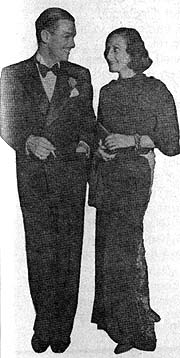 Joan with Doug Fairbanks, Jr., her first husband, 1929 |
 With 2nd spouse, Franchot Tone |
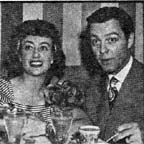 Philip Terry, Joan's # 3 Mate |
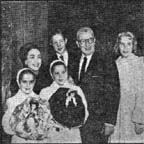 Alfred Steele, # 4 & adopted kids |
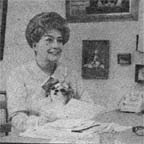 Joan, at home, with Princess | |
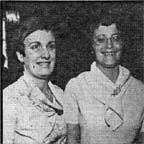 Twins Cathy & Cindy at funeral |
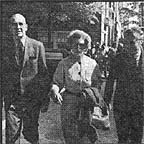 Myrna Loy only star at funeral |